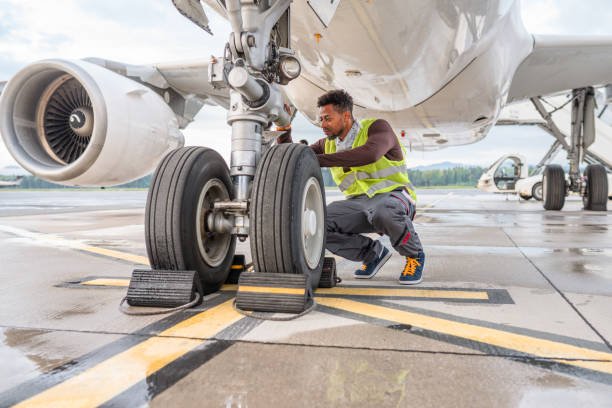Key Takeaways
- Ground Support Equipment (GSE) is essential for the efficiency and safety of aviation operations.
- Modern GSE contributes to the precision of military and civilian aviation tasks.
- The evolving technology in GSE has reduced the risk of on-ground mishaps.
Table of Contents
- Understanding Ground Support Equipment (GSE)
- Role of GSE in Aviation
- GSE in Defense Operations
- Technological Advancements in GSE
- Safety Enhancements with Modern GSE
- Importance of Training and Education
- Environmental Impact and Sustainability
- Future Prospects of GSE
Understanding Ground Support Equipment (GSE)
Ground support equipment encompasses various vehicles and apparatuses specifically engineered to aid various ground functions crucial for seamless aviation operations. This equipment ranges from fuel trucks to passenger stairs, and their efficiency ensures that all preparatory steps before a flight’s departure are conducted promptly. This meticulous process is vital as it directly impacts the flow of air traffic, emphasizing the core role of Ground Support Equipment (GSE) in streamlining the turn-around times at airports. Its availability and functionality are just as critical as the aircraft, confirming the need for reliable and consistent maintenance of these ground assets.
Role of GSE in Aviation
In aviation, where precision is non-negotiable, GSE is a key player. The equipment used not only facilitates the operational readiness of aircraft but also ensures passenger safety and comfort. For instance, baggage loaders and conveyor belts are essential for handling luggage efficiently and minimizing delays and loss incidents. Technically, equipment like hydraulic test units ensures that aircraft are in optimal condition before taking off. By maintaining a high standard of operational effectiveness, GSE plays a pivotal role in reducing ground time for aircraft, thus enhancing the efficiency of airlines. These aspects were touched upon in aviation ground support vehicle reviews, which underscore the necessity of well-oiled ground operations within the broader context of aviation management.
GSE in Defense Operations
In defense operations, the stakes are higher, and the precision of ground support equipment becomes even more crucial. Military aircraft need to be ready for deployment at any given moment, and GSE ensures this readiness by facilitating essential support tasks like refueling and equipment testing. The strategic advantages of efficient GSE translate to better mission preparedness and execution. They also play a significant role in logistics and supply chain management within military bases, ensuring that all aircraft operations run smoothly and without delay. For defense fleet management, reliable ground support equipment eliminates bottlenecks, strengthening the defense infrastructure.
Technological Advancements in GSE
The evolution of technology has remarkably transformed ground support equipment, incorporating features like smart diagnostics and Internet of Things (IoT) connectivity, which enhance both efficiency and reliability. Such advancements allow ground crew to monitor equipment health in real-time, predict maintenance needs, and thus prevent unforeseen breakdowns. Automation and innovative solutions are pivotal in modernizing many GSE processes, reducing costs, and improving productivity. A closer look at recent ground support technology trends shows how these technological improvements are essential for reducing downtime and operational costs, ultimately supporting more sustainable aviation practices.
Safety Enhancements with Modern GSE
Safety improvements in modern GSE cannot be overstated. With features such as automated collision avoidance and enhanced stability controls, the risk of accidents around aircraft on the tarmac is significantly reduced. These safety systems are especially critical during high-traffic operations, helping protect ground operators and aircraft from potential harm. Additionally, new safety guidelines and regulations continually shape how GSE is manufactured and utilized, emphasizing a zero-tolerance approach to accidents and mishaps. Consequently, well-maintained and technologically advanced GSE contributes to a secure airport environment, engendering trust in ground operations among airlines and passengers alike.
Importance of Training and Education
While advanced technology significantly contributes to the smooth operation of GSE, skilled personnel ensure these machines perform at their best. Comprehensive training programs are essential for equipping ground staff with the know-how to handle this sophisticated equipment efficiently. Such education not only improves operator competency but also boosts morale by highlighting the importance of their role in aviation safety and operational efficiency. Ongoing learning and development are essential in keeping pace with technological advancements, ensuring that staff remains proficient with new equipment and compliant with evolving industry standards and regulations.
Environmental Impact and Sustainability
The push towards greener and more sustainable aviation practices has significantly impacted the development of GSE. Manufacturers are increasingly focusing on designing equipment that reduces emissions and energy consumption. Electric GSE and hybrid models are becoming mainstream, promoting environmental sustainability and adherence to global emissions regulations. These eco-friendly alternatives contribute to considerable reductions in the carbon footprint of aviation operations, aligning with global sustainability goals and responding to the growing awareness of environmental issues within the industry. By fostering sustainable practices, the aviation industry can contribute positively to combating climate change.
Future Prospects of GSE
The future of ground support equipment lies in the continued integration of advanced technologies such as artificial intelligence and robotics, which promise to make ground operations more accurate and less resource-intensive. Innovations in automation will likely lead to enhanced operational efficiency, allowing airlines to streamline processes further and allocate resources more effectively. This technological trajectory suggests that future GSE will be networked with other aviation systems to provide seamless, end-to-end solutions for ground operations. As needs and challenges in aviation evolve, so will the capabilities and contributions of ground support equipment, ensuring that it remains an indispensable component of global aviation and defense strategies.











